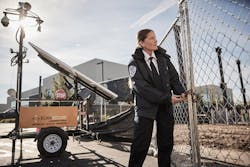The Shifting Paradigm of a Technology-Driven Guard Force
The security industry is undergoing a profound transformation driven by rapid technological advancements. Traditional methods of safeguarding assets and ensuring safety are being enhanced—and in some cases, entirely replaced—by innovative, technology-driven approaches. This shift reflects a broader trend toward integrating cutting-edge technologies with human expertise. The value of human contribution in creating more effective and adaptive security solutions cannot be overstated. As technology continues to evolve, its impact on the security industry is becoming increasingly significant, paving the way for a new era of security management that is not only responsive to emerging threats but also proactive in identifying and mitigating potential risks. This emphasis on the value of human expertise in conjunction with technology makes the audience feel integral to the process.
Historically, security operations heavily relied on human personnel. Guards were strategically stationed to monitor activities, patrol areas, and respond to incidents. While these traditional methods were effective to a certain extent, they faced inherent limitations. Despite their vigilance, human guards were constrained by factors such as fatigue, limited capacity for data processing, and the sheer scale of areas requiring oversight. While invaluable for its intuition and adaptability, the human element could not always keep up with the demands of large-scale or complex security environments. As security threats evolved in complexity and scale, a pressing need emerged for more sophisticated, scalable solutions to address these challenges more effectively. This need underscores the value of technological advancements in the security industry, as they can overcome these limitations and provide more effective security solutions.
Adopting a Hybrid Approach to Security
Integrating technology into security operations achieves a significant paradigm shift. This new approach not only enhances the capabilities of human guards but also creates a hybrid model where technology and human expertise work in harmony. The result is a significant improvement in threat detection and response capabilities, effectively addressing the limitations of traditional security methods.
This continuous, real-time monitoring and rapid data analysis ensure potential threats are identified and addressed promptly, reducing response times and mitigating risks before they escalate. Moreover, integrating technology allows for better resource allocation, enabling human guards to focus on tasks that require critical thinking and situational awareness while leaving routine surveillance and data processing to automated systems.
A key driver of this transformation is the rapid advancement in technology. Artificial Intelligence (AI), the Internet of Things (IoT), and Big Data are at the forefront of this evolution. AI has revolutionized security with predictive analytics, facial recognition, and behavior analysis capabilities. For example, predictive analytics can analyze vast amounts of data to identify patterns and anticipate potential threats before they materialize. IoT, on the other hand, enables the connection and communication of devices over the internet, enhancing monitoring and surveillance capabilities. Additionally, AI technologies are continually evolving, promising even more sophisticated capabilities in the future, such as enhanced object recognition and deeper integration with other security technologies.
Facial recognition technology enhances access control and surveillance, allowing for real-time identification and monitoring of individuals. Behavior analysis tools can detect suspicious activities by analyzing patterns in behavior, providing valuable insights for pre-emptive action.
Utilizing IoT Systems to Enhance Monitoring and Surveillance
The IoT plays a crucial role in modern security solutions by connecting various smart devices and sensors to create an integrated network of real-time monitoring tools. This interconnected system enhances security by enabling continuous surveillance and immediate responsiveness to environmental changes. For instance, smart sensors can detect deviations in environmental conditions, such as unauthorized access attempts, fire hazards, or unusual temperature fluctuations, and provide instant alerts to security personnel. This capability not only allows for prompt intervention but also facilitates preventive measures. Integrating IoT devices enables the automation of routine security tasks, such as locking doors, adjusting lighting, and managing access control systems based on real-time data.
Furthermore, the data collected from these sensors can be analyzed to identify patterns and trends, offering valuable insights into potential vulnerabilities and helping to optimize security measures. The use of IoT in security operations also supports remote monitoring, allowing security teams to manage and respond to incidents from anywhere, thus improving operational efficiency and ensuring a more proactive approach to threat management
Big Data and analytics further enhance security operations by enabling data-driven decision-making. By analyzing data from multiple sources, security teams can identify trends, analyze incidents, and make informed decisions about resource allocation and response strategies. This approach improves the efficiency of security operations and provides a deeper understanding of potential vulnerabilities and threats.
Cloud computing has also revolutionized the security industry by offering scalable storage solutions and remote access capabilities. Security teams can store and manage vast amounts of data in the cloud, including video footage and system logs. This flexibility ensures data is accessible from anywhere, facilitating continuous monitoring and control. Cloud technology enables security personnel to manage operations remotely, providing enhanced responsiveness and oversight.
Financial Efficiency with Improved Security Performance
Another significant advantage of integrating technology into security operations is cost efficiency. Automation substantially reduces the need for extensive manpower, leading to lower operational costs and more streamlined processes. For instance, advanced automated surveillance and access control systems can perform tasks that previously required human intervention, such as monitoring multiple camera feeds simultaneously, managing access credentials, and responding to security breaches. This optimizes resource allocation, minimizes labor costs, and reduces the risk of human error.
Additionally, automated systems can operate around the clock without breaking or downtime, ensuring consistent security coverage and reducing the likelihood of missed incidents. By implementing such technologies, organizations can achieve a more cost-effective security solution while reallocating human resources to roles that require critical thinking and decision-making. Over time, the initial investment in these technologies can lead to significant savings, as automation helps prevent potential losses and mitigate risks more efficiently. This financial efficiency and improved security performance underscores the value of adopting technological advancements in modern security operations.
Embedding advanced technologies directly benefits security. Automated systems can monitor large areas more effectively than human guards alone, providing real-time alerts and detailed analysis of security incidents. This proactive approach ensures that potential threats are addressed before they escalate, reducing response times and improving overall safety.
With the rise of technology-driven security solutions, regulatory compliance has become increasingly important. Organizations must ensure their systems adhere to industry standards and data protection laws. Implementing technologies such as AI and IoT requires careful consideration of data privacy and security, ensuring that all systems comply with relevant regulations and safeguard sensitive information.
Despite the numerous benefits, challenges, and considerations associated with adopting technology in security operations. Data privacy and security are paramount, as organizations must implement robust measures to protect sensitive information and comply with data protection laws. Integration with existing systems can also pose challenges related to compatibility and interoperability, requiring careful planning and execution to ensure seamless operation.
The cost of implementing new technologies can be significant, and organizations must balance this initial investment with the long-term benefits. Training and adaptation are crucial for the successful implementation of technology-driven solutions. Security personnel must be educated on new tools and systems to understand how to use them effectively. Additionally, maintaining and ensuring the reliability of technological systems is essential for consistent performance and security. Regular updates, maintenance, and support are necessary to keep systems running smoothly and address any issues.
Future Proofing Security
Looking to the future, advancements in AI will continue to enhance threat detection and response capabilities. The adoption of 5G technology will revolutionize security operations by providing faster and more reliable real-time communication and data transfer. Augmented Reality (AR) and Virtual Reality (VR) technologies will play a significant role in training and simulation, offering realistic scenarios for security personnel to prepare for various situations. AR and VR can simulate complex security incidents, providing immersive training experiences that enhance preparedness and response skills.
Blockchain technology can potentially enhance data security by securing transactions and communications. Its decentralized nature ensures that data is tamper-proof and transparent, making it an ideal solution for securing sensitive information. Sustainable solutions will focus on eco-friendly and energy-efficient technologies, reflecting the industry's commitment to environmental responsibility. For example, solar-powered security cameras and energy-efficient systems will reduce the environmental impact of security operations.
The paradigm shift towards technology-driven guard force solutions offers numerous benefits, including increased efficiency, cost-effectiveness, and enhanced security. By strategically planning and investing in these technologies, organizations can stay ahead in the evolving security landscape. Addressing data privacy, system integration, cost, training, and maintenance challenges will be crucial for successful implementation. As technology advances, the security industry will benefit from more sophisticated tools and solutions, ultimately creating safer environments for security professionals and the communities they protect.
In conclusion, integrating technology into security operations signifies a profound evolution in the industry. This hybrid approach seamlessly blends advanced technologies with human expertise and offers a more comprehensive and adaptive security solution than traditional methods alone. As security threats become increasingly complex and widespread, leveraging cutting-edge technology to enhance operational efficiency and effectiveness is essential for safeguarding assets and ensuring safety. Technology improves real-time threat detection and response, optimizes resource allocation, and reduces operational costs.
The future of security will be profoundly shaped by continued innovation, with emerging technologies playing an ever-more central role in protecting people and assets. From advancements in artificial intelligence and machine learning to breakthroughs in real-time data analysis and automated systems, the landscape of security is rapidly transforming. As these technologies evolve, they will offer new capabilities and solutions to address broader risks and challenges. Adapting to these changes will be crucial for maintaining robust security frameworks capable of responding to the dynamic nature of contemporary threats. In this evolving environment, staying at the forefront of technological advancements will ensure that security measures remain effective, proactive, and resilient against emerging risks.
Ally Happel is the Senior Vice President of Sales at GardaWorld Security for the United States, where she leads her team in spearheading organic growth initiatives and business development endeavors. Collaborating closely with GuardaWorld's operations team, Happel ensures clients have tailored solutions while maintaining optimal security throughout the year.
Case study: Benefits of integrating technology and guarding
A leading Fortune 50 logistics company faced significant security challenges at its Los Angeles warehouse facility, including homelessness, graffiti, trespassing, and vandalism. To address these issues, GardaWorld implemented a cost-effective and comprehensive security solution by integrating GardaWorld Security’s industry-leading guard services with ECAMSECURE’s advanced virtual gateguarding technology. This synergy provided full perimeter security across the facility, including parking lots, logistics centers, packaged cars, airlines, and corporate offices, while significantly reducing overall costs. GardaWorld Security’s on-site guards, in close collaboration with ECAMSECURE’s dedicated Command Center operators, responded instantaneously to threats. Equipped with ECAMSECURE’s motion detection technologies, the guards effectively warded off trespassers and vandals, preventing illegal encampments. Strategically placed AI-powered mobile Surveillance Units (MSUs) enhanced the guards’ line of sight, offering comprehensive visibility, especially in dark corners of the premises. The reinvested cost savings allowed for added value and protection through customizable services, including Pan-Tilt-Zoom (PTZ) cameras, thermal cameras, and radar video surveillance, ensuring a robust security framework tailored to the client’s specific needs.
About the Author

Jordan Lippel, CPP
Vice-President of Sales for ECAMSECURE, a GardaWorld company
Jordan Lippel is a Certified Protection Professional with over 25 years of experience in crime prevention security technology. He has acquired security expertise in artificial intelligence, risk assessments, and behavioral intelligence. As Vice-President of Sales for ECAMSECURE, a GardaWorld company and leader in innovative, adaptable access and surveillance security solutions, Lippel is responsible for business development across North America, focusing on integrated security solutions. Lippel is also a member of the Board of Directors of ASIS International’s Crime Prevention Council, Los Angeles Crime Stoppers, the Ventura County Sheriff Foundation, and LEAPS (CAL-ORCA).


